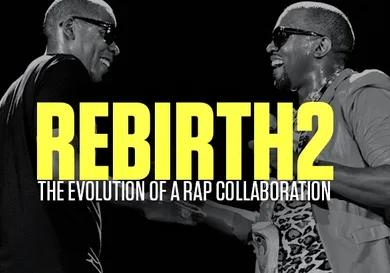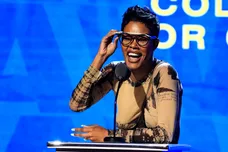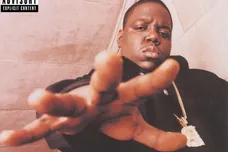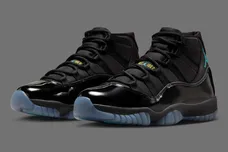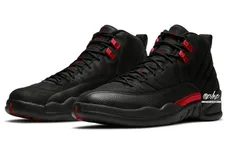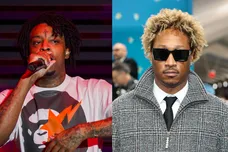Competition breeds success. No disrespect to Drake, but this motto could trump Y.O.L.O. So much so that, in hip-hop, the saying can be modified to read “competition breeds superiority.” Nowhere is that more present than in the situation known as the collaboration. Following up last week's discussion of a rap group, we now turn to look at how the idea of a 'collaboration' has evolved since rap's heyday.
The idea of your favorite rapper doing a song with your other favorite artist was a genuine event before the rise of the Internet, knowing that the two MCs actually met in the studio, spent time with each other and came up with something that was a certified classic. Oftentimes, whether intentionally or unintentionally, the pairing results in a friendly rivalry to see which artist outdid the other. Fans play the ultimate judge and choose sides.
And while competition is a motivator, for some it goes deeper. With new artists, collaborations can be used for building a healthy buzz towards a long career, filled with ride or die supporters. Veteran rhymesayers can take it as an opportunity to win over naysayers as well as cement their legacy as the best that ever did it. Whether it was A Tribe Called Quest hooking up with Leaders of the New School to outline “The Scenario” or Dr. Dre laying the groundwork for the Death Row invasion and domination in the '90s with late night sessions populated with weed, alcohol and hungry MCs, a collaboration wasn’t just business. It was personal.
As hip-hop evolves, so does the meaning and way rappers come together for a song. Although the process of going to the studio to meet producers and fellow artists is not an entirely lost experience, you can’t deny that social media and the Internet have changed the way we get our collabos. A simple meet-and-rhyme has turned into e-mail and a meet later, with the collaborating artists some times only connecting for the first time when they have to shoot the video or perform the song live. It seems strange, but is there any proof beyond the occasional picture in the studio that rappers truly go in together on a chosen track? And even with that, there’s no guarantee that anything has taken place. It can often times simply be a way to build buzz and keep the artists' name in people’s mouths.
The music is good and the rhymes are hot, but where’s the real connection? Is there anything that truly proves a collaboration existed between two talented MCs? Did they even get a sense of how to approach the tune or was it just general instructions to spit “a hot 16?”
Even producers aren't in the studio with the artists as much, since they simply e-mail beats to the artist. There's no sense of personal touch, to produce something that feels natural. Nowadays, it all seems "factory made."
Only the artists know for sure, though. One thing’s certain. Fans are smart enough to know when those “keeping it real” aren’t real enough to make their collaborations an experience that demands to be felt. So let’s pour some liquor, shall we, and reminisce over the life and times of the collaboration.
Collaboration for Superiority
Competition and rap go hand in hand. Name one rapper who doesn’t go into a collaboration with thoughts of coming out on top. It’s the unwritten commandment: Thou shalt always murder whoever thou collaborate with.
Kendrick Lamar may have shined a light on it on “Control” (“I got love for you all but I'm tryna murder you niggas/Trying to make sure your core fans never heard of you niggas/They don't wanna hear not one more noun or verb from you niggas/ What is competition? I'm trying to raise the bar high), but Biggie Smalls and Jay Z personified it while working on “I Love the Dough” from B.I.G.’s Life After Death.
“Jigga and Big, them niggas was really battling,” Nashiem Myrick, a producer on the song, recalled to XXL magazine. “Both of them don't write their rhymes down, they just say it in their heads. On the low, they was going at it. Not going at each other in the lyrics, but going at it skill-wise. It was a sight to see. It was like, ‘Let me see what this nigga is going to do in the booth.’ You could tell they were testing each other.”
Although, the song was more battle ready for its legendary competitors, “I Love the Dough” opened the door for paying homage to the folks who made the original tune a classic, while taking things to the next level.
“I had no idea what Big was gonna put to it…Big came in with Jay, and they start cross-pacing. Imagine two people, pacing back and forth, crisscrossing each other, and not looking at each other, doing their writing process in their head, mumbling to themselves, getting their lyrics right and kickin' it with each other in between. They was taking their time,” Easy Mo Be told XXL. “They had gone and got Angela Winbush. [When I heard] Big, Jay-Z and Angela Winbush, reiterating "I Love You More" to "I Love the Dough," I fell out. I was like, Oh man, they doing their thing….They went and got the original artist. Have her sing the hook over, not just sing the hook over but reiterate and change the words up.”
For Winbush, “I Love the Dough” introduced her to a new generation of folks who weren’t exposed to the original composition. Just as non-rhymesayers benefit from the cross-promotion, the same can be said for rappers who elevate their stock with a fatefully planned pairing outside rap circles.
One Nation Under One Collaboration
MCs linking up with singers is hardly anything new. For every “I Feel For You,” (Chaka Khan and Melle Mel), “Friends” ( Jody Watley and Eric B & Rakim) and “Fantasy” remix (Mariah Carey and Ol’ Dirty Bastard) there is a “Dark Horse” (Katy Perry and Juicy J), “Dirrty” (Christina Aguilera and Redman) and “Radioactive” remix (Imagine Dragons and Kendrick Lamar).
Juicy J may have an Oscar and some pre-solo fame as a member of Three 6 Mafia, but his stock increased significantly in the mainstream eyes when Perry’ herself green-lighted his verse after meeting and working with him to produce what eventually made the cut.
“She’s very professional, everything went smooth and she’s a great person,” Juicy J told MTV’s Sway Calloway. “My verse I did on that song, she was singing it. She’s really a genius, she was by the mixing board and telling the guy what to take in and take out. She’s really hands-on with her music, she knows sic.”
And the rest they say is Billboard history. Perry got another #1 hit. Juicy got that, plus exposure to a new audience of followers.
More exposure through a cameo is just the tip of the iceberg. Upon writing the “I’m Real” and “Ain’t It Funny” remixes for Jennifer Lopez, Ja Rule inherited a new job title: R&B songwriter. Among those requesting the Murder Inc. rhymer’s writing skills were Mariah Carey, Brandy, Macy Gray and Enrique Iglesias.
Ja may have embraced his collaborative skills with a rhyme and soulful mind state, but ironically, Run DMC was not totally on board with doing the song that opened up all the collabos that followed. According to reports, the late Jam Master Jay was the only member of the trio who was willing to remake Aerosmith’s “Walk This Way.” Fortunately for us, Run and DMC changed their mind and laid vocals down.
And we haven’t looked back since, as artists like Limp Bizkit were able to venture outside their main genre to deliver "a track that was straight up hip-hop" with DJ Premier and Method Man (“N 2 Gether Now”). Even country music artists weren’t immune as Nelly took his country grammar to Tim McGraw (“Over and Over”) and Florida Georgia Line (“Cruise” remix), not to mention Taylor Swift getting her semi-gangsta on with T-Pain (“Thug Story”).
So yes, hip-hop has benefitted greatly from collabos, in-house or otherwise. But the question remains…with technology changing the game, is it more an asset or death sentence when it comes to artists and fans living one nation under a natural collaboration?
Technology: A Collaboration’s Best Frenemy
The internet is a bag of mixed results. It can limit our access to each other just as much as it can help advance our cause.
With everyone being “busy,” there’s seemingly no time for folks to meet up to collaborate. Instead, hitmakers fall back on the convenience of e-mail to get their rhymes and beats to whoever they would like to work with.
Despite satisfying results, the reality is that many collaborating artists know each other more by their Twitter handle and e-mail addresses than their actual stage name. Not personal. Just business.
“They were mastering the last song and he put a stop on it and extended [the deadline for delivering the final album] a week so he would have more time to get his verse done,” J. Cole said in 2011 regarding Jay Z turning in a verse for “Mr. Nice Watch,” a song off Cole’s debut album Cole World: The Sideline Story.
Although Jigga’s 11th hour delivery wasn’t necessarily a good look on his part, it did add to the anticipation for Cole’s work. Nevertheless, they could’ve used some guidance from The Foreign Exchange.
The duo known as The Foreign Exchange, comprised of NC-based lyricist Phonte and Dutch record producer Nicolay, created its first album Connected by sending and recording music via e-mail, instant messaging and traditional mail. The album, released in 2004, is an example of a quality piece of work coming from musicians who never had a connection outside the world of music, much less met each other face-to-face (although they finally met following the LP release), and indeed, that was the whole point.
The power of the online message board. Gotta love it.
Personal or impersonal, we won't be seeing any lack of collaborations in present day or the future. As long as it strikes a nerve with the listener, that’s all that counts, right? The true test comes years later, when we find out whether or not the collaboration withstood its own era and remains a force in a new era of hip-hop. Is it strong enough to last or will it easily blow away? The answer lies with the creators, the collaborators and ultimately the motivation behind it all: You.
